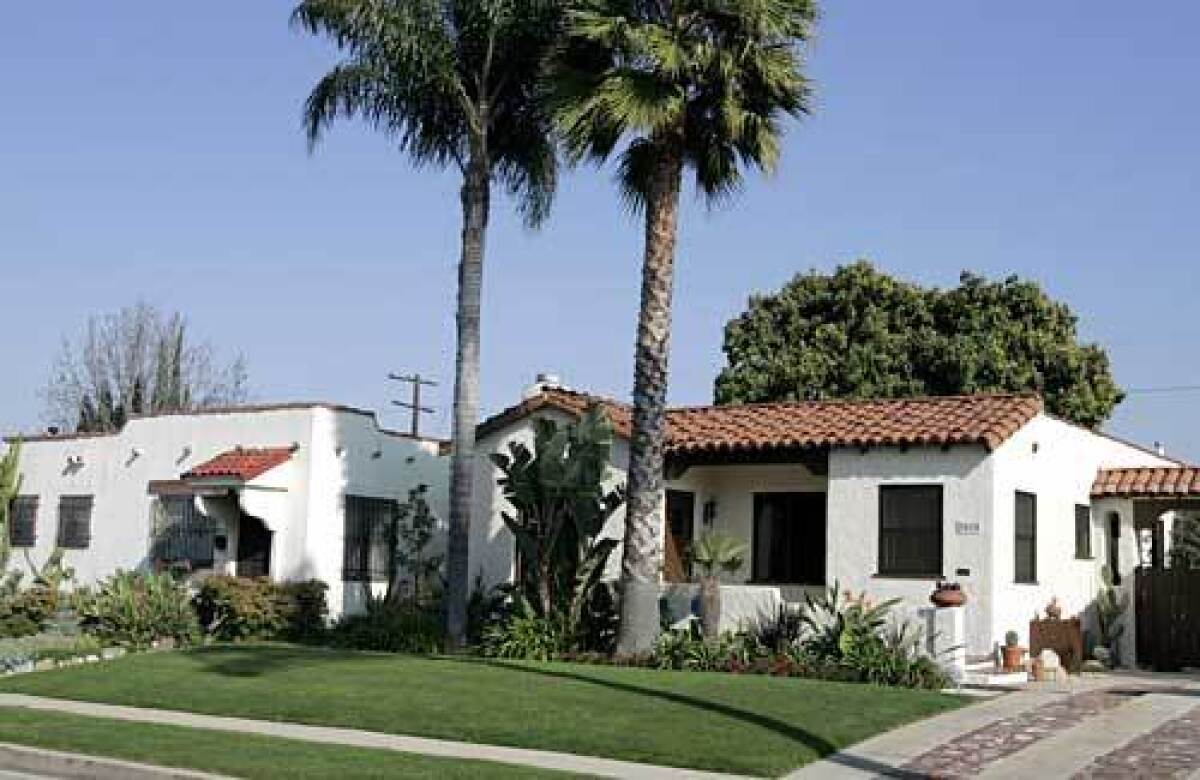Spanish style still defines central pocket

- Share via
Beginnings
A well-preserved 1 1/2 -story adobe in the heart of this small West Los Angeles neighborhood speaks to its early days as part of the Rancho Rincon de los Bueyes (which means “corner of the oxen”). Built in 1865 by Antonio Jose Rocha II, the privately occupied residence at 2400 Shenandoah St. in 1963 became Los Angeles’ 13th historic-cultural monument.
In 1923, the area’s co-owners, Citizens Trust & Savings Bank and Title Insurance & Trust Co., filed to subdivide it into a neighborhood of single-family homes.
Insiders’ view
The neighborhood is racially and ethnically mixed. In recent years, it has attracted a rising number of entertainment industry and other professionals, including chefs, accountants and consultants. Variety, the entertainment industry publication, lands each morning on many a driveway.
The pocket is bounded by Cadillac Avenue on the north, Holt Avenue on the east, Cattaraugus Avenue on the south and Robertson Boulevard on the west.
Real estate agents have long described the area as “Beverlywood adjacent” or “south Robertson,” but the name Reynier Village is starting to catch on. Activists have revived the Reynier Village Neighborhood Assn., an informal group that alerts residents to developments by e-mail and distributes fliers about meetings and other happenings.
Drawing card
The neighborhood is centrally located, just north of the Santa Monica Freeway and about midway between downtown Los Angeles and the beach. If the freeway is flowing, downtown Los Angeles or Santa Monica is a 10-minute drive away. Locals tend to take La Cienega Boulevard to LAX, a 15-minute jaunt in light traffic.
It also contains fine old houses, many of them Spanish Revival in style, loaded with original charm and relatively affordable, at least by the current dizzying standards.
Housing market
In 2004, the neighborhood saw some of the fastest housing-price appreciation on the Westside. At the peak of the sizzling market last year, one house was listed at just under $900,000. The house just sold for $825,000, said agent Denise Fast of Re/Max, who added that her client is having “seller’s remorse” because she was so fond of the neighborhood.
Lately, properties have taken longer to sell. In recent weeks, half a dozen houses in the area have been on the market, priced at $640,000 to $850,000.
Spanish Revival-style stucco bungalows predominate. Most were built in the late 1920s or 1930s and have two or three bedrooms. They intermingle with an eclectic assortment of pitch-roofed cottages and tract houses, many painted in rainbow hues or earth tones. Most residences are still single-story, but one also encounters the occasional grandiose two-story replacement for a teardown. A number of remodels, including some second-story additions, are underway. A caveat: The neighborhood is teeming with higgledy-piggledy “guesthouses” and add-ons, many built without permits and not to code.
Original houses are replete with details such as hardwood floors, crown moldings, arched doorways, curved ceilings — and, unfortunately, dinky Depression-era closets. Many owners have replaced their front lawns with Mediterranean or cactus-and-succulent gardens.
Good news, bad news
Neighborhood icons along Robertson, the main drag, include the 55-year-old Beverlywood Swim School, with its bright blue exterior and patient instructors, who teach 20,000 private lessons a year. Residents also frequent the family-owned Emil’s Hardware, opened in 1947 by a butcher from Lackawanna, N.Y., and his two sons. The stretch of Robertson between Cadillac and Hamilton High School features a number of antiques stores, sharing the space with tattoo parlors, psychics and an assortment of flooring, heating and upholstery businesses.Residents yearn for a nice cafe, sushi bar or coffee shop. Many of the commercial properties are owned by absentee landlords, who have resisted neighbors’ efforts to upgrade the storefronts. Residents gravitate toward the Helms Bakery Building on Venice Boulevard, with its collection of home furnishings and design shops, galleries and restaurants.
As for crime, Los Angeles police officer Mario Gonzalez said the south-of-Cadillac area he oversees has traditionally had a little crime, “but nothing substantial or significant.” “We’ve had some burglaries, but it’s not going out of control,” he said. North of Cadillac is another story, with a lot of property crime and some crime against people. Gang members’ tagging has also been a persistent problem in Reynier Village. Residents recently organized a neighborhood watch program.
Report card
On the 2005 Academic Performance Index Growth Report, the local Shenandoah Street Elementary School scored 654 out of a possible 1,000. Families say they are working with Shenandoah administrators to improve the school. The “local” middle school is Mark Twain Middle School, five miles away in Mar Vista; it scored 609. Hamilton High School scored 678. Most families in the neighborhood send their children to private schools or to other public schools, such as Castle Heights Elementary, Palms Middle School and LACES (Los Angeles Center for Enriched Studies), a public magnet school for grades six through 12.
Historical values
Residential resales:
Year...Median Price
1990...$321,5001995...$212,000
2000...$334,000
2004...$675,000
2005...$728,750
*
Sources: South Robertson Neighborhoods Council, https://www.soronc.org ; SoRo Inc., https://www.soro.org ; Los Angeles Police Department; DataQuick Information Systems



